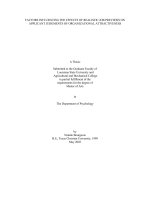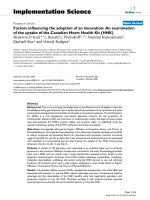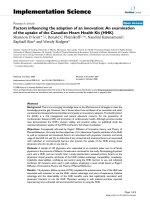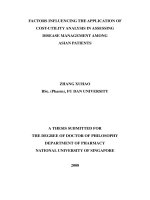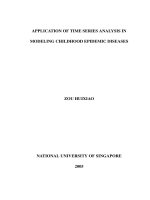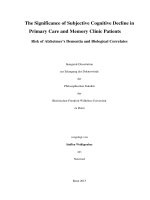Factors influencing the application of cost utility analysis in assessing disease management among asian patients
Bạn đang xem bản rút gọn của tài liệu. Xem và tải ngay bản đầy đủ của tài liệu tại đây (969.22 KB, 250 trang )
FACTORS INFLUENCING THE APPLICATION OF
COST-UTILITY ANALYSIS IN ASSESSING
DISEASE MANAGEMENT AMONG
ASIAN PATIENTS
ZHANG XUHAO
BSc. (Pharm), FU DAN UNIVERSITY
A THESIS SUBMITTED FOR
THE DEGREE OF DOCTOR OF PHILOSOPHY
DEPARTMENT OF PHARMACY
NATIONAL UNIVERSITY OF SINGAPORE
2008
Acknowledgements
Completing this thesis has been a very challenging but always inspiring journey.
At the very beginning of this thesis, I would like to take this opportunity to express
my most sincere gratitude and appreciation to all those who have given me kind
support throughout this journey.
I am immensely grateful to my wonderful supervisors, Prof. Li Shu-Chuen and
Prof. Julian Thumboo, for their tremendous dedication throughout my Ph D studies.
They have offered me invaluable guidance and encouragement on how to be a capable
and independent investigator, which has become and would remain as the most
important treasure to me and my entire career. I also feel very indebted to them, as
they have also sacrificed a lot of their personal time to thoroughly review and
comment on various study protocols, manuscripts, and thesis, which enabled me to
improve continuously. Special thanks also go to Prof and Mrs. Li for all their care and
love to me, not only as supervisor but also just like my parents.
I am very grateful to all my collaborators from different institutions and
organizations, Prof. Fong Kok-Yong, Drs Lo Ngai-Nung, Yeo Seng-Jin, Yang Kuang-
Ying, Tan Hwee-Huan (Singapore General Hospital), Dr. Kevin Tan (Diabetic
Society of Singapore), Dr. Wee Hwee Lin and Ms. Jin Jing (National University of
Singapore) and Dr. Xie Feng (McMaster University, Canada). They have given me
great insights, valuable comments and kind support throughout the collaboration.
Many thanks are also due to Assoc. Prof. Paul Ho and Asst Prof. Chui Wai
Keung (my Ph D thesis advisory committee), Assoc Prof. Chan Sui Yung (Head of
Department), and Assoc Prof Chan Lai Wah (Chairman of Pharmacy Graduate
Program Committee), and all the other staff and fellow students in my department for
their crucial support and invaluable advice throughout my Ph D studies. I also would
i
like to thank the Department of Pharmacy and International Society of
Pharmacoeconomics and Outcomes Research for awarding me the research
scholarship and travel grants.
As I joined Merck Sharp & Dhome at the end of the 3 year, I really would like
to appreciate the tremendous understanding and support from my managing director
(Ms. Annie Chin), my ex-medical director (Dr. Lai Hung Jen), my manager (Mr. Lee
Jet Tong) and all the other fellow colleagues.
rd
Last but not least, my deepest gratitude goes to my parents (Mr. Zhang Ji Hua and
Mdm Xiao Ming Qi), my husband (Mr. Leon Xu), my very cute "Shitzu" sister (Sissy)
and all the other family and extended family members and friends for their endless
love and unflagging support throughout my life.
ii
Table of Contents
Acknowledgements………………………………………………………………. i
Table of Contents………………………………………………………………… ii
Summary ………………………………………………………………………….vii
List of Tables………………………………………………………………………x
List of Figures…………………………………………………………………… xiii
Chapter 1. Introduction ………………………………………………………….1
1.1 What is disease management? … 2
1.2 How to assess disease management? ………………………………… 4
1.3 What is the role of cost-utility analysis (CUA) in assessing disease
management? ………………………………………………………………7
1.4 Why explore factors influencing the application of CUA to assess disease
management among Asian patients? ………………………………………10
1.5 Research objectives…………………………………………………….16
Chapter 2. Translating and culturally adapting the English version of Audit
of Diabetes-Dependent Quality of Life (ADDQoL) into Chinese—An exploratory
study based on the universalist approach……………………………………….20
2.1 Introduction ……………………………………………………………21
2.2 Methods……………………………………………………………… 25
2.3 Results………………………………………………………………….33
2.4 Discussion………………………………………………………………45
2.5 Conclusion…………………………………………………………… 47
Chapter 3. A Qualitative Review of Factors Influencing Cost-Utility Analysis in
assessing disease management ………………………………………………… 48
3.1 Introduction…………………………………………………………….49
3.2 Methods……………………………………………………………… 51
iii
3.3 Results………………………………………………………………….52
3.4 Discussion………………………………………………………………80
3.5 Conclusion…………………………………………………………… 82
Chapter 4. Is Diabetes Knowledge Associated with Health Utility Values among
Subjects with Diabetes? A Preliminary Study among English-speaking Diabetic
Subjects in Singapore …………………………………………………………….83
4.1 Introduction…………………………………………………………… 84
4.2 Methods…………………………………………………………………85
4.3 Results………………………………………………………………… 89
4.4 Discussion………………………………………………………………92
4.5 Conclusion………………………………………………………………95
Chapter 5. Exploring the Impact of Health Literacy on Utility Assessment and
Health-Related Quality of Life among Patients with Rheumatic Diseases…….96
5.1 Introduction…………………………………………………………… 97
5.2 Methods………………………………………………………………….99
5.3 Results………………………………………………………………… 102
5.4 Discussion………………………………………………………………110
5.5 Conclusion…………………………………………………………… 113
Chapter 6. Development and Validation of a generic functional health literacy
test (GFHLT)………………………………………………………………………114
6.1 Introduction…………………………………………………………… 115
6.2 Methods……………………………………………………………… 118
6.3 Results………………………………………………………………….123
6.4 Discussion…………………………………………………………… 127
6.5 Conclusion…………………………………………………………… 129
iv
Chapter 7. An Exploratory Study of Response Shift in Health-Related Quality of
Life (HRQoL) and Utility Assessment among Patients with Osteoarthritis
Undergoing Total Knee Replacement Surgery…………………………………131
7.1 Introduction…………………………………………………………….132
7.2 Methods……………………………………………………………… 135
7.3 Results………………………………………………………………….138
7.4 Discussion…………………………………………………………… 146
7.5 Conclusion…………………………………………………………… 150
Chapter 8. Applying the Expectancy-Value Model to Understand Health
preferences…………………………………………………………………… 151
8.1 Introduction…………………………………………………………….152
8.2 Methods……………………………………………………………… 153
8.3 Results………………………………………………………………….158
8.4 Discussion…………………………………………………………… 166
8.5 Conclusion…………………………………………………………… 170
Chapter 9. Development and Validation of a Scale to measure Patients’ Trust in
Pharmacists………………………………………………………………………171
9.1 Introduction……………………………………………………………172
9.2 Methods……………………………………………………………… 174
9.3 Results…………………………………………………………………178
9.4 Discussion…………………………………………………………… 185
9.5 Conclusion…………………………………………………………….188
Chapter 10. A Recapitulation of Major Findings, Contributions, Limitations,
and Future Studies……………………………………………………………….189
10.1 General introduction………………………………………………….190
10.2 Major findings……………………………………………………… 190
v
10.3 Main contributions……………………………………………………195
10.4 Main limitations………………………………………………………197
10.5 Future studies…………………………………………………………197
Bibliography………………………………………………………………………199
Appendices……………………………………………………………………… 218
vi
SUMMARY
Due to the aggregated impact of rising chronic disease prevalence and increasing
demand for better quality of health care, disease management has been increasingly
emphasized across Asia to achieve optimal health outcomes at affordable
expenditures. In order to ensure that disease management programs are realizing their
value-adding capacities to health care systems, it is essential to apply economic
evaluations like cost-utility analysis (CUA) as a decision making tool to improve
resource allocation and optimization.
Currently, the number of high-quality CUA studies in this region is quite limited
compared to that in Western countries; and, direct CUA result generalization from
Western studies could not be substantiated due to differences in socio-cultural, socio-
economic, and various other factors. Hence, in order to reduce the need to replicate
CUA performed in western countries, it is necessary to identify the factors influencing
the generalization of CUA to ensure its role in assessing efficiency of disease
management programs in Asian countries.
Within this framework, this thesis is organized to achieve the following
objectives:
• To evaluate whether there is any linguistic or cultural barrier in the adaptation of
an English health-related quality of life (HRQoL) or utility instrument into a non-
English version, as this may influence the results of CUA analyses which require a
HRQoL instrument.
• To review the factors found to influence the application, and hence its
generalization of CUA in the published literature.
• To explore other new factors that may potentially influence the application of
CUA of disease management programs in Asia.
vii
The performed studies revealed the following findings:
• First, minor linguistic and cultural differences did exist between original English
version and the translated Chinese version. More importantly, we demonstrated
that it was essential to adopt the universalist approach to ensure all important
equivalences, namely, conceptual, item, semantic, operational, measurement and
functional equivalences were all sequentially and adequately demonstrated during
the adaptation process.
• Second, we identified altogether 20 factors from the published literature, which
could be used as a reference list by Asian researchers and decision-makers when
conducting or adopting CUA analyses. These factors could be further grouped
into five categories as treatment-related (duration, efficacy, and frequency),
disease-related (severity level, risk level, incidence rate, prevalence rate, disease
progression rate and survival length), patient-related (age, gender, race/ethnicity
and compliance), cost-related (treatment cost variation, incorporation of indirect
cost), and methodology-related factors (discount rate, QALY elicitation method,
statistical uncertainty, handling of confounding variables and reliability of data
source).
• Third, health psychology-related factors such as response shift and expectancy-
value could significantly influence the measurement of HRQoL and utility values,
thus impacting CUA results. Comparatively, patient empowerment-related factors
such as health literacy and disease knowledge had minimal impact on these values.
We also developed and validated two new scales (the generic functional health
literacy test and patient's trust in pharmacists scale), which demonstrated high
reliability and good construct validity. Their impact on CUA would need further
investigation.
viii
In conclusion, we would suggest that if impossible or infeasible to replicate CUA
performed in Western countries in an Asian environment, the decision makers need to
consider the potential impact of at least the factors we identified when adopting CUA
results in formulating policy.
ix
List of Tables
Table 1.1 The four basic economic analyses to assess disease management
programs…………………………………………………………………………… 8
Table 1.2 National Health Accounts of Selected Asian Countries………………….12
Table 2.1 Characteristics of study subjects………………………………………….34
Table 2.2 Reliability of the Chinese –ADDQOL……………………………………38
Table 2.3 Comparison of response distribution between the English and the Chinese
samples………………………………………………………………………………39
Table 2.4 Use of N/A options between the English and the Chinese
samples……… 41
Table 2.5 Comparison of item ranking with and without importance weighting by
language…………………………………………………………………………… 42
Table 2.6 Spearman rank correlation among Chinese-ADDQOL weighted mean
scores,” Present HRQoL”, “HRQoL without DM”, EQ-5D utility, SF-6D and
FFM scores ………………………………………………………………………….44
Table 3.1 Treatment-related factors that affect cost-utility ratio…………………….58
Table 3.2 Disease-related factors that affect cost-utility ratio……………………….63
Table 3.3 Patient-related factors that affect cost-utility ratio……………………… 69
Table 3.4 Cost-related factors that affect cost-utility ratio………………………… 73
Table 3.5 Methodology-related factors that affect cost-utility ratio…………………78
Table 4.1 Characteristics of study subjects and scores of diabetes knowledge, health
utility and HRQoL ………………………………………………………………… 90
Table 4.2 Correlation between diabetes knowledge and health utility values and
HRQoL scores……………………………………………………………………….92
Table 5.1 Subject Characteristics…………………………………………………104
x
Table 5.2 Comparison of health utility and HRQoL scores of patients with rheumatic
diseases by health literacy levels…………………………………………………105
Table 5.3 Correlation between health literacy level and HRQoL and utility scores of
patients with rheumatic diseases………………………………………………….107
Table 5.4 Impact of health literacy level on the physical functioning of patients with
rheumatic diseases using multiple linear regression models…………………… 109
Table 6.1 Subject Characteristics…………………………………………………124
Table 6.2 Item difficulty and item discrimination of the GFHLT……………… 126
Table 7.1 Subject Characteristics………………………………………………….139
Table 7.2 Horizontal comparisons between pre- and then-test, and between true
change and observed change at baseline and six months after total knee
replacement……………………………………………………………………… 141
Table 7.3 Response shift in domains of SF-6D at baseline and six months after total
knee replacement………………………………………………………………….143
Table 7.4 Influence of external variables on respective response shift at baseline and
six months after total knee replacement ………………………………………….144
Table 8.1 Characteristics and health preferences of 232 survey respondents…….161
Table 8.2 Correlation between health values and attitudinal attributes………… 163
Table 8.3 Score distribution of attitudinal attributes of Expectancy-Value Model by
health state ……………………………………………………………………… 164
Table 8.4 Comparison of explanatory power of expectancy-value model versus
external variables only……………………………………………………………165
Table 8.5 Contribution of each attitudinal attribute to explaining health
Preferences……………………………………………………………………… 166
Table 9.1 Item generated from focus group approach and response analysis…….180
xi
Table 9.2 Item analyses of 18 candidate items……………………………………181
Table 9.3 Demographic and background information of respondents……………183
Table 9.4 Factor analysis and reliability of the 12-item trust scale……………….184
xii
List of Figures
Fig.1.1 Plan, Do, Check and Act (PDCA) cycle for Disease Management………….4
Figure 3.1 Article selection process …………………………………………………55
Figure 7.1 Bland-Altman Plot: Difference vs. Average of response shift measured
by EQ-5D and SF-6D……………………………………………………………….145
xiii
1
Chapter One
Introduction
2
1.1 What is disease management?
With the ultimate aim to improve the quality of healthcare delivery, disease
management is a knowledge-based integrative process intended to continuously
maximize the effectiveness of health care delivery at lowest possible expenditures
from the perspectives of those who receive, purchase, provide, supply and evaluate it
(Couch, 1998; Fritzner et al., Quality and Research Committee, Disease Management
Association of America, 2004). In the new millennium, disease management has been
increasingly emphasized due to the high prevalence rate of chronic diseases, the
pressure of cost containment and the need to improve quality of health care (Fritzner
et al., 2004; Fernandes, 2002; Ofman et al., 2004). In Asia, as projected by the United
Nations in 2001, the aging population (i.e., the number of people aged 65 and above)
in this region will increase by 314 percent, from 207 million in 2000 to 857 million in
2050 (United Nations, 2001). Such a dramatic increase in aging population has been
shown to exert ever increasing health and economic burdens on the health care
systems across Asia (World Health Organization, 2007). This phenomenon has forced
reconsideration about the mode of health care delivery to ensure that acceptable health
outcomes can be achieved with affordable expenditure.
Previously, health care was delivered in a so-called “component management
system”, which often led to increased total treatment cost without the expected
improvement in patient outcomes (Todd et al., 1997). Comparatively, in the system of
disease management, patients themselves together with other various stakeholders
(e.g., policy makers, purchasers, payers, providers, practitioners and product
producers, etc.) are included in the value chain of health care delivery with the aims to
optimize clinical, economic, humanistic (including quality of life and satisfaction)
3
outcomes at the lowest possible expenditure (Couch, 1998). This represents a shift
from the “piece-meal” approach of health care delivery by individual providers to a
more coordinated and streamlined approach aiming to achieve an outcome agreed by
all stakeholders. Therefore, the sustainable success of disease management requires
refined evidence-based practice guidelines for practitioners, enhanced capability of
self-management of patients, valid and reliable outcomes measures by researchers and
robust decision-making models for policy makers.
A comparison of the processes of implementing disease management shows that
the advocates of disease management approach of health care delivery have borrowed
the practices and concepts of total quality management from the business world and
applied it to health care with the focus on outcome-based care (Gilmour et al., 1995;
Rall et al., 1997; Grol, 2000).
As such, the disease management approach also
incorporates a feedback loop mechanism to complete the quality improvement cycle
known as “Plan-Do-Check-Act” (PDCA) cycle (Figure 1.1). In the Plan-Do-Check-
Act loop, assessing disease management could be considered as the procedure of
“Check”. Therefore, the assessment of disease management not only answers whether
disease management is executed properly, but suggests areas for further improvement
as well.
4
Fig.1.1 Plan, Do, Check and Act (PDCA) cycle for Disease Management
1.2 How to assess disease management?
Despite the theoretical benefits of disease management approach over the
traditional mode of health care delivery, any disease management program needs to be
evaluated to ascertain whether it is realizing its value adding capacity to the health
care system. Disease management could be assessed by three major categories of
indicators, namely, structure, process and outcomes indicators (Donabedian, 1966). As
defined, structure indicators are used to examine physical and organizational
properties of health care settings. Process indicators reflect what and how well disease
management is executed. Outcomes indicators are applied to show the end results of
disease management, such as changes in health status, life expectancy, health-related
quality of life (HRQoL) and health care costs (Donabedian, 1980).
Theoretically, outcomes indicators have been regarded as the most
comprehensive and representative indicators of the three types. It has been argued that
outcomes indicators could directly evaluate the efficiency of disease management
PDCA cycle for
disease
management (DM)
Act
Refine and
modify DM
accordingly
Plan
z Determine the disease to
manage
z Identify patients with the
disease
z Develop a standardized
method of intervention
Do
Apply DM
Check
Monitor outcomes
of DM
5
programs, in terms of cost and effectiveness. If designed properly, they are able to
reflect all aspects of structure and process, including those that are not measurable or
have not been measured yet (Steuten et al., 2006).
However, in reality, it has been found that process indicators were predominantly
chosen to assess efficiency of disease management programs, which should have been
properly co-examined by outcomes indicators (Mant, 2001). Such phenomenon could
be due to the reason that processes are generally easier to measure than outcomes
because measuring outcomes requires development and application of new
instruments/methods and it usually takes much more time and efforts (Donaldson et
al., 2004; Bratzler et al., 2007). Furthermore, outcomes especially from patients’
perspectives have not been assessed in a holistic approach, which may lead to
potential misinterpretation of the efficiency of a disease management program
(Steuten et al., 2006; Ritterband, 2000).
In order to ensure that disease management programs deliver the best outcomes
with minimal economic resources, that is, to achieve efficiency in delivery, it is
necessary for decision makers to apply systematic economic evaluations to appraise
both costs and benefits in a balanced way with no outcome being maximized to the
detriment of the other (Gunter, 1999). Based on the guideline issued by the Disease
Management Association of America (DMAA) on the "principles of assessing disease
management outcomes", it was emphasized that all three types of outcomes, namely,
economic, clinical and humanistic outcomes should be evaluated in the assessment of
disease management Fritzner et al., Quality and Research Committee, Disease
Management Association of America, 2004). One of the most comprehensive
6
approaches proposed to evaluate outcomes in disease management has been known as
ECHO model, which stands for a model evaluating economic, clinical and humanistic
outcomes (Reeder, 1995; Gunter, 1999; Kemp, 2006). Clinical outcomes measure the
end-points of medical events that occur as a result of disease or treatment and have
been used routinely without any controversy in health care settings. Economic
outcomes refer to direct, indirect and intangible costs associated with the
consequences of medical treatment alternatives or preventions. In the age of cost
containment in the realization that resource available for health care is limited, the
inclusion of economic outcomes in the assessment of a disease management program
is deemed necessary to address the concern of accountability. Humanistic outcomes
are consequences of disease or treatment on patient’s functional status or quality of
life (e.g. physical functioning, social functioning, general health and well-being, and
life satisfaction). Additionally, satisfaction with health care services and results of
treatment were also an integral part of humanistic outcomes. Comparatively, this is a
newer concept of outcome indicator used in measuring the efficiency of a disease
management program. Nevertheless, considering that the health care delivery
occurring in any disease management program can be conceptualized as a humanistic
exchange between the providers and the receivers (patients in this case), it would be
logical to include the impact from the perspective of the receiver. Hence, the ECHO
model of assessing outcomes in disease management has been gaining increasing
acceptance since its proposal.
Since the adoption of ECHO model, apart from continuous efforts in seeking
better clinical indicators, there have been increasing research endeavors in the
development and validation of patient-reported outcome measures (e.g. HRQoL,
7
functioning and satisfaction measures) to evaluate humanistic outcomes, which could
further contribute to the accurate assessment of either benefit or effectiveness in
economic evaluations (Kind, 2001; Korolija, 2007).
The other equally important issue in the application of ECHO model to assess
disease management is to enhance the robustness of economic modeling, which has
been heavily pursued by developing and refining guidelines, consolidating individual
approaches, and seeking appropriate application of these approaches for various
purposes (Fleurence et al., 2007; Mason et al., 2006; Inadomi, 2004; Siegel et al.,
1997).
Nevertheless, for a brief summing up, the outcome indicators from the ECHO
model are being increasingly used in economic evaluation of disease management
program worldwide and signify a philosophical shift in assess efficiency of health
care delivery.
1.3 What is the role of cost-utility analysis (CUA) in assessing disease
management?
Currently, there are altogether four basic economic evaluations used to assess
disease management programs, namely, cost-minimization analysis (CMA), cost-
benefit analysis (CBA), cost-effective analysis (CEA) and cost-utility analysis (CUA)
(Johannesson,1996). Collectively speaking, all of these four economic evaluations
generate results by comparing both the cost and health outcomes of two or more
interventions using one formula, with difference in costs presented in the nominator
and difference in health outcomes in the denominator.
8
As shown in Table 1.1, the four economic analyses share one commonality, that is,
to measure costs in monetary value. Except for CMA which assumes the health
outcomes to be the same and thus requires no measurement, all the other three types
of economic evaluations measure health outcomes in different ways. CBA measures
health outcomes in monetary value, which has generated argument that it is
inappropriate and difficult to place a dollar value on human life. Comparatively, both
CEA and CUA measure benefits in non-monetary units such as quantity or quality of
life, which are more acceptable and make clinical sense in the assessment of health
care (Muenning, 2002).
Table 1.1 The four basic economic analyses to assess disease management programs
Type of analysis Costs Outcomes Comments
Cost Benefit
Analysis (CBA)
In monetary units In monetary terms Less commonly used as it
is difficult to quantify
human life in monetary
units
Cost Minimization
Analysis (CMA)
In monetary units Assuming
equivalence in
outcomes
To identify the cheapest
program when the
outcomes are assumed to
be the same.
Cost-effectiveness
analysis (CEA)
In monetary units In physical or
natural units
Mainly used to compare
programs across the same
disease/treatment
Cost-utility
analysis (CUA)
In monetary units In utility-weighted
life years
Allows comparison
across different
diseases/treatment
However, more specifically, the unit of health outcome measures also differs
between CUA and CEA, whereby CUA measures health outcomes in utility-weighted
life years and computes a cost per utility-measure ratio for comparisons across
different interventions (Gerard, 1992). Consequently, CUA has been recommended as
the preferred form of reporting health economic evaluation results by the Panel on
9
Cost-Effectiveness in Health and Medicine (Siegel et al., 1996).
In CUA, the utility-weighted life years could be either calculated as Quality-
Adjusted Life Years (QALYs) or Disability-Adjusted Life Years (DALYs) (Gold, 2002;
Torrance, 1997; Sassi, 2006).
Congruent with the purpose of maximizing allocative efficiency in disease
management, the use of such a standardized index in CUA would allow not only
comparison of cost-effectiveness among interventions for the same disease or
condition, but also comparison across interventions for different diseases or cost-
effectiveness of different health service programs. This is a distinct advantage over
the use of CEA where the major concern would be that of technical efficiency.
Regarding the standard index commonly used in CUA, besides quantity of life
(life expectancy), QALYs also incorporate quality of life (health utilities), which has
been shown to be a very useful and important humanistic endpoint to assess the
effectiveness of treatment, particularly in chronic diseases where mortality is not the
major issue or when the primary purpose of the intervention is palliative rather than
curative (Burger, 2003; Merhrez et al., 1989; Raisch, 2000). Health utilities could be
either elicited by direct measurement using Time Trade-Off (TTO), Standard Gamble
(SG) and Rating Scale (RS) (Morimoto et al., 2002), or by indirect measurement
using utility-based Health-related Quality of Life (HRQoL) instruments such as SF-
6D (Brazier et al., 2002), EQ-5D (The EuroQol Group, 1990), Health Utilities Index
Mark 2 (HUI2) (Torrance et al., 2002) and Mark3 (HUI3) (Feeny et al., 2002).
10
In comparison, DALYs can be viewed as a form of unequally weighted QALYs,
which assign different weights to different age groups when quantifying the burden of
disease (Murray, 1994). Yet, all other non-health characteristics of an individual are
arbitrarily ignored, which is based on Murray and Acharya’s ethical principle that all
other factors should play no part in deciding health care priorities (Murray, 1997).
Due to the increased complexity in DALYs calculations and widely challenged
conceptual and technical soundness, DALYs are much less adopted than QALYs as a
standardized form to measure benefits in CUA (Fox-Rushby, 2001), but used more
commonly in assessment of burden of illness.
Hence, this near univocal acceptance of QALY as the outcome indicator in
CUA should promote the application of CUA in evaluating disease management at
least theoretically.
1.4 Why explore factors influencing the application of CUA to assess disease
management among Asian patients?
Despite heterogeneities, health care systems across Asia are facing unprecedented
and unparalleled increase in health care expenditure, due to the aggregated impact of
rapid growth in aging population, rising prevalence in chronic diseases and increasing
demand of better quality of health care (Clark, 2004; Cheah, 2001; East West Center,
2002). For most of the countries in the region (as shown in Table 1.2), although the
total expenditure on health as percentage of Gross domestic product (GDP) is seen to
be more or less stable, yet when GDP growth is factored in, the per capita total
expenditure on health is found to be subject to continual growth at relatively high
rates (World Health Organization, 2007). With the rapidly ageing of populations in the
11
region as previously mentioned, this trend is likely to continue if not escalated in the
next few decades. Some sort of systematic approach, such as the adoption of disease
management would be necessary to ensure that the increased health care expenditure
is delivering the required outcomes. Hence, economic evaluations like CUA would
play a significant role in improving the rationality of disease management in terms of
resource allocation and optimization.
Probably due to the fact that disease management assessment is still a relatively
emerging area in Asia, the number of high-quality CUA studies is quite limited in this
region compared with that in Western countries. Direct generalization of CUA results
from studies in the West could not be substantiated, as variations in the CUA results
have been found even across different locations in those countries (Sculpher et al.,
2004). Hence, it is deemed necessary to perform CUA based on local populations and
health care settings to generate more accurate appraisal of the locally implemented
disease management programs.
However, for the successful application of CUA to assess the efficiency of disease
management programs in Asian countries, there are a number of factors either as
barrier(s) or concerns that need to be solved or addressed.
